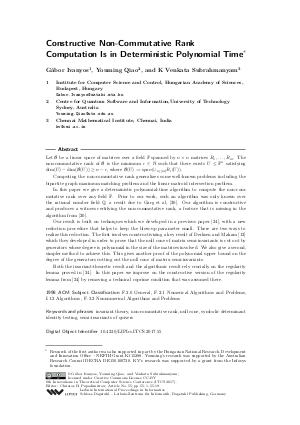Constructive Non-Commutative Rank Computation Is in Deterministic Polynomial Time
Authors Gábor Ivanyos, Youming Qiao, K Venkata Subrahmanyam
-
Part of:
Volume:
8th Innovations in Theoretical Computer Science Conference (ITCS 2017)
Part of: Series: Leibniz International Proceedings in Informatics (LIPIcs)
Part of: Conference: Innovations in Theoretical Computer Science Conference (ITCS) - License:
 Creative Commons Attribution 3.0 Unported license
Creative Commons Attribution 3.0 Unported license
- Publication Date: 2017-11-28
File

PDF
LIPIcs.ITCS.2017.55.pdf
- Filesize: 0.56 MB
- 19 pages
Document Identifiers
Subject Classification
Keywords
- invariant theory
- non-commutative rank
- null cone
- symbolic determinant identity testing
- semi-invariants of quivers
Metrics
- Access Statistics
-
Total Accesses (updated on a weekly basis)
0Document
0Metadata
Abstract
Let {\mathcal B} be a linear space of matrices over a field {\mathbb spanned by n\times n
matrices B_1, \dots, B_m. The non-commutative rank of {\mathcal B}$ is the minimum r\in {\mathbb N} such that there exists U\leq {\mathbb F}^n satisfying \dim(U)-\dim( {\mathcal B} (U))\geq
n-r, where {\mathcal B}(U):={\mathrm span}(\cup_{i\in[m]} B_i(U)).
Computing the non-commutative rank generalizes some well-known problems including the bipartite graph maximum
matching problem and the linear matroid intersection problem.
In this paper we give a deterministic polynomial-time algorithm to compute the
non-commutative rank over
any field {\mathbb F}. Prior to our work, such
an
algorithm was only known over the rational number field {\mathbb Q}, a result due to Garg et al, [GGOW]. Our algorithm is constructive and produces a witness
certifying the non-commutative rank, a feature that is missing in the algorithm from [GGOW].
Our result is built on techniques which we developed in a previous paper [IQS1], with a new reduction procedure that
helps to keep the blow-up parameter small. There are two ways to realize this
reduction. The first involves constructivizing a key result
of Derksen and Makam [DM2] which they developed in order to prove that the null cone
of matrix semi-invariants is cut out by generators whose degree is polynomial in the size of the matrices involved. We also give a second, simpler method to achieve this. This
gives another proof of the polynomial upper bound on the degree of the generators cutting out the null cone of matrix
semi-invariants.
Both the invariant-theoretic result and the algorithmic result rely crucially
on the regularity lemma proved in [IQS1]. In
this paper we improve on the constructive version of the regularity lemma from [IQS1] by removing a technical coprime
condition that was assumed there.
Cite As Get BibTex
Gábor Ivanyos, Youming Qiao, and K Venkata Subrahmanyam. Constructive Non-Commutative Rank Computation Is in Deterministic Polynomial Time. In 8th Innovations in Theoretical Computer Science Conference (ITCS 2017). Leibniz International Proceedings in Informatics (LIPIcs), Volume 67, pp. 55:1-55:19, Schloss Dagstuhl – Leibniz-Zentrum für Informatik (2017)
https://doi.org/10.4230/LIPIcs.ITCS.2017.55
BibTex
@InProceedings{ivanyos_et_al:LIPIcs.ITCS.2017.55,
author = {Ivanyos, G\'{a}bor and Qiao, Youming and Subrahmanyam, K Venkata},
title = {{Constructive Non-Commutative Rank Computation Is in Deterministic Polynomial Time}},
booktitle = {8th Innovations in Theoretical Computer Science Conference (ITCS 2017)},
pages = {55:1--55:19},
series = {Leibniz International Proceedings in Informatics (LIPIcs)},
ISBN = {978-3-95977-029-3},
ISSN = {1868-8969},
year = {2017},
volume = {67},
editor = {Papadimitriou, Christos H.},
publisher = {Schloss Dagstuhl -- Leibniz-Zentrum f{\"u}r Informatik},
address = {Dagstuhl, Germany},
URL = {https://drops.dagstuhl.de/entities/document/10.4230/LIPIcs.ITCS.2017.55},
URN = {urn:nbn:de:0030-drops-81667},
doi = {10.4230/LIPIcs.ITCS.2017.55},
annote = {Keywords: invariant theory, non-commutative rank, null cone, symbolic determinant identity testing, semi-invariants of quivers}
}
